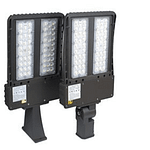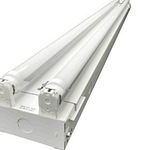The types and varieties of LEDs grow every day it seems, but today we are taking it back to the basics. We are here today to answer the ever present question of, “How are LEDs made?” We’ll take you through a quick background on the key differences between LED lights and traditional lights, what materials go into creating the light emitting diode, how those materials are designed and, finally, how they are connected together to create the most energy efficient light on the market!
Background: LEDs vs Traditional Lights
LED lighting and incandescent and fluorescent lights are not only designed differently, they create light differently. Traditional lighting creates light by attaching wires to a source of energy. When the wires heat up, they emit light. LEDs create light by electronic excitation as opposed to heat. This is why LEDs use less energy and emit less heat, as heat is not a main component in creating light.
LED Materials
LED stands for light emitting diode. Therefore, LED lights are made up of small diodes. Each diode is created from semiconductor material. One of the layers of semiconductor material will have an excess of electrons, one layer will be depleted of electrons. This difference in electron levels allows electrons to move from one layer to the next, creating light through electronic excitation mentioned above.
To break it down a little further, the semiconductor material itself is made of crystalline material and needs impurities in order to conduct electricity. However, these impurities are added to the semiconductor material later on in the manufacturing process.
However, do not mistake these impurities as imperfections in the semiconductor material. They do not lessen the value of the diode, they enhance it! Adding these impurities to the semiconductor is called doping and it is an essential material used in the making of LEDs. The most common impurities added are zinc and nitrogen.
Finally, in order to power the diodes, electrical wires must be added. Gold and silver compounds are often used in LED wires, as they can handle being soldered and heat well. Lastly, to finish it off, the diodes are encased in a transparent plastic, not glass like traditional bulbs, making them durable and long-lasting.
LED Design
When designing LED lights, there is a bit more creativity allowed. Depending on the application of the light, color temperature, brightness and efficiency are decided before any manufacturing takes place. These attributes are decided based on the size of the diode, the semiconductor material used, the types of impurities added and and the thickness of diode layers.
Manufacturing: How LEDs are Made
The manufacturing of LEDs is a delicate and complex matter, but we’ll do our best to sum it up. First and foremost, the semiconductor material must be made. This is called the semiconductor wafer. The semiconductor material is “grown” in a high temperature, high pressure chamber. Elements such as gallium, arsenic, and/or phosphor are purified and mixed together in the chamber, which then liquefies into a concentrated solution. Once the elements are mixed, a rod is placed in the solution and slowly pulled out. The solution crystallizes on the end of the rod as it is pulled out, creating a long, cylindrical crystal ingot.
This material is then sliced into semiconductor wafers and essentially sanded down, much like you would sand down a table, until the surface is smooth. Then, it is dipped into a solution of various solvents for a rigorous cleaning to rid it of any dirt, dust or organic material.
In the next step of the process, additional layers of semiconductor material are added to the wafer. This is one way to add impurities, or dopents.
Next, metal contacts are defined on the semiconductor. This is determined in the design stage and takes into account whether the diode will be used individually or with others.
Lastly, diodes are mounted onto the appropriate package, wires are attached and then everything is encased in plastic. That’s how LEDs are made!
Learn more about LEDs with Sitler’s!
If you have more questions about LEDs, visit or FAQ page or our blog on what exactly is an LED! Give us a call today at (319)-519-0039 to start your LED journey!
Posted in LED Lighting Basics















